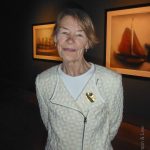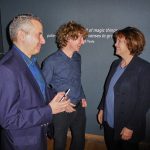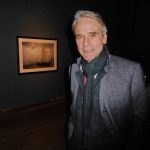The Science Museum Group’s collection of historical models has been re-imagined by fine art photographers Jonathan Anderson and Edwin Low to give them a hazy, romantic quality, reminiscent of paintings by J. M. W. Turner.
They may be images of old model ships but they conjure up evocative new narratives: dramas about storm-tossed journeys through vast seascapes, epic tales of voyages to strange lands, and stories of legendary vessels that loom from ominous fogs.
So who better to enjoy Voyages, a transport to fantastical worlds, than leading creative figures who attended the Arts and Media Lunch this month, organised by the Mail on Sunday Arts Correspondent Chris Hastings, with the support of Michael G Wilson of Eon, who previously invited Anderson and Low to create an art project around the James Bond movie Spectre.
Addressing the assembled throng about the museum’s forthcoming Illuminating India festival was somewhat intimidating: before me were actors such as Glenda Jackson, Jenny Agutter, John Sessions, Reece Shearsmith, Miranda Richardson, Imogen Stubbs, Rebecca Night, Patricia Hodge, Adrian Dunbar, Haydn Gwynne, David Bamber, Mark Bazeley, Greta Scacchi and Jeremy Irons; there were creative figures such as directors Sir Alan Parker, Stephen Frears and Stephen Poliakoff, novelist and poet Ben Okri, choreographer Arlene Phillips, lyricist Don Black, artistic Director of the RSC, Gregory Doran, playwright Christopher Hampton, photographer Alison Jackson, David Austin, Chief Executive of the British Board of Film Classification, screen writers Andrew Davies, Dominic Minghella, Bill Nicholson and Daisy Goodwin, scientists Nicola Clayton, Alan Winfield, Steve Jones, Lord Robert Winston, Dame Jane Francis, and Clive Oppenheimer; along with journalist Dame Jenni Murray of the BBC and Andrew Cohen, the BBC’s Head of Science.
Before lunch and a tour of Robots, I introduced Anderson and Low, who gave our distinguished guests a mesmerising introduction to Voyages in the evocative light of Media Space, which is now displaying their surprising reinterpretation of a much-loved collection of maritime models.
Anderson & Low commented that their Voyages exhibition is about “…using one’s imagination and sharpening one’s senses, and that if one does this, then one can find magic everywhere. One of the singular parallels in the history of science and art is that one can look at the world in a different way, and re-imagine what it might be.”
They also cited Turner – “I paint what I see, not what I know to be there” – and eminent physicist William Bragg who declared: “The important thing in science is not so much to obtain new facts as to discover new ways of thinking about them.”
The model ships at the heart of the exhibition were displayed for almost half a century before the museum’s Shipping Galleries were decommissioned in 2012.
The models have been subject to careful conservation over the intervening years and Anderson and Low took the unusual step of viewing them through the slightly opaque sheeting used to protect them from dust and degeneration.
Creating images of the models this way, the sheeting acted like a prism to reveal how the models contained inner dramas which were just waiting to be discovered.
The resulting images look almost like paintings and as Anderson and Low explained “push the boundaries of what a photograph is supposed to do.”
Rather than represent photography as a purely representational art, or as an instrument to examine the detailed structures of these models, they have transformed the medium into a means to enthral, beguile and enchant.
Voyages can be seen in the Media Space gallery until 25 June.



















